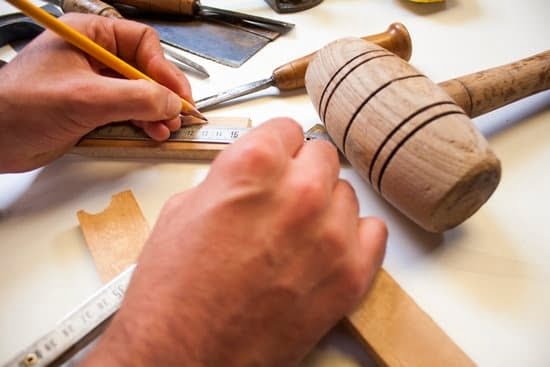Introduction
Woodworking joinery is a technique used to join two pieces of wood together, creating a stronger joint than traditional fastening methods. Joinery provides superior strength and stability when connecting wood pieces as well as offering a pleasing aesthetic. It is important to understand the various joinery techniques so you can select the best option for your woodworking application.
Benefits of woodworking joinery include added rigidity, durability, and beauty to projects. By creating strong joints with well-crafted handmade dovetails or lap joints you are ensuring the highest quality and longevity for whatever piece you are building. For those interested in increasing their skill level, the craftsmanship involved in learning and perfecting these joints can be very rewarding. With experience, confidence builds and furniture makers gain better accuracy with each joint they craft. Joinery also serves a decorative purpose as well, since simple but clean lines of interlocking dovetails or mortise and tenon joints can add great visual interest to any project.
Types of Joinery
Fine woodworking joinery encompasses the joining of two or more pieces of wood through various methods, to create a durable and aesthetically pleasing connection. Types of fine woodworking joinery include:
• Dovetail joints ” These interlocking shapes are among one of the strongest forms of joinery; typically used for corners and composition panels in furniture.
• Mortise & tenon joints ” This type of joint is created by inserting a protruding “tenon” into an accurately cut receptacle, or “mortise”. It is often used in furniture frame construction including log cabin concepts.
• Biscuit joints ” A small round disc, often made from compressed wooden material (similar to particle board) is glued onto two opposing surfaces then a clamping machine is used to pinch the surfaces together with extreme force. It is often used where alignment accuracy and strength are needed most such as cabinetry.
• Dowel joints ” Small cylindrical objects usually made from hardwood are inserted into pre-drilled holes on the surface of two or more pieces then secured with glue. Dowel joints are best used when precision and accuracy count most such as joining cabinet face frames together.
• Finger joints – Also known as box joints, these interlocking fingers resemble small dovetails but are referred to differently because they’re commonly found in drawers or boxes rather than frames. The fingers promote better alignment which makes for a tighter joint when compared to other methods like biscuit joins for instance.
• Lap Joints – One board overlapping another board over half its thickness creates this strong joint that’s often seen in frame structures including table saw fences and rafters for roofs . When additional strength and rigidity is required along with decorative appeal, lap joints offer great advantages for all sorts of projects.
Biscuit Joints
Biscuit joints are a popular form of joinery used in fine woodworking. This type of joint utilizes thin, oval-shaped wooden biscuits that are inserted into slots on the end grain of two boards in order to create an incredibly strong connection. The biscuit joint is especially useful when creating surfaces, such as tabletops or cabinets, with multiple panels that require alignment. Once the two boards have been connected with the biscuit, they can be further secured with glue and then clamped together until dry. The beauty of this joint is that it doesn’t require complicated tools or complex cutting techniques ” just simple tools and basic precision will suffice. Biscuits can also be combined with other forms of joinery for additional strength and stability, such as using screws along either side of the biscuit or using dowel pins as an additional structural element to save time and effort. With proper planning, biscuit joints provide an excellent yet easy way to produce beautifully crafted projects using a minimum amount of materials and effort.
Dowel Joints
A dowel joint is a type of woodworking joinery where two pieces of wood are joined by inserting a round peg, or dowel, into pre-drilled holes. This type of joint requires no glue and is often used to connect furniture components as it can be quite strong. Dowel joints have been around for centuries, but modern twist drills with mortising jigs have made the process much easier and more accurate. When making a dowel joint one needs to make sure the hole sizes match accurately ” too small of a hole and the dowels won’t fit tight enough; too large and you’ll need considerable amount of force to get it in. Also, you want to make sure that there are no gaps between the two pieces once assembled ” if this is not the case then you need to reassess your pilot holes, as they may not be correctly aligned. To ensure strength, try gluing the dowels in place and/or use moisture proof wood glue when assembling them. You can also add an adhesive film over the joint. A benefit of using dowels over other forms of joinery such as nails or screws is that they don’t leave visible marks once installed, providing for a clean finish at the end of your project.
Miter Joints
A Miter Joint is one of the most common joinery methods used in woodworking. It is used to create a strong, attractive connecting corner joint in a frame or other construct that is aesthetically pleasing. The miter joint uses two pieces of wood cut at 45 degree angles and fitted together so that they form an X. This creates an extremely strong connection between the two pieces ” one which will not easily break or come apart through wear-and-tear use. Beyond this basic construction, there are many variations to the miter joint, such as the housing miter, lap miter, and stopped miter joints can be modified to give professionals and hobbyists more flexibility with their designs. Middle Bites and Rabbet Miters are traditionally used to join multiple pieces of trim, such as baseboard molding or window casings, but may also be adapted for larger furniture applications.
Rabbet Joints
A rabbet joint is an incredibly versatile and effective joinery method used to make a decorative corner, reinforce a rectangle frame, or create a floored recess. There are two parts to this joint: the rabbet cut in one piece of wood and the tongue cut in the second. The two pieces fit together so that the tongue fits snugly into the rabbet and holds them firmly together.
This type of joint is commonly found in cabinet making, picture framing, door production, and other furniture construction projects. To construct a rabbet joint, one board needs to be cut at an angle ” usually straight down from the top edge of the wood – creating a “lip” that fits like a tongue into the lip of the second piece of wood. This cut is typically made using either a router or table saw. It is important to secure both pieces together for safety reasons when using power tools for this kind of work as misplaced cuts can be disastrous!
The strength of these joints depend greatly on how precisely they have been cut, with most professional projects requiring perfectly-fit joints with some form of adhesive applied to provide additional holding power if needed. Clamping both pieces together before any adhesive cures completely is essential for optimal performance as it helps secure extra pressure on each side of the joint. By taking care with your measurements and secure clamping practices you can ensure strong bond lines between pieces produced by this joining method.
Dado Joints
A dado joint is a joining technique used in woodworking to join two pieces of wood together by creating a groove along each edge. The grooves are machined into the pieces using a router or table saw and fitted with pieces of hardware such as dowels or biscuits. This allows for a tight and secure join that won’t work itself loose over time as long as it’s properly secured. Dado joints are often used when creating shelves, boxes, and other types of cabinetry and furniture. They’re especially popular when putting together drawers, as it provides both practicality and strength in the construction of the joint. Additionally, certain types of dado joints can be made to look decorative, transforming them from strictly utilitarian wooden accents into sophisticated design elements.
Festool DOMINO Joints
Festool DOMINO joints are an innovative type of joinery that allows woodworkers to create exceptionally strong joints without the need for traditional mortise and tenon joinery. This system uses wooden mortises, but rather than cutting them out with a router, a Domino joining tool creates neat holes in the wood which allow a unique and strong joint to be formed quickly and easily. The strongest advantage of this joinery system is its capacity for strength – once joined, the Domino joint can carry substantially more load than traditional mortise and tenon joinery. It also requires far less precision detail work and hassle, since the required holes are cut precisely by the tool. Finally, they are also much easier to dismantle or refine than mortar-and-tenon as they require no glue or additional fixings. DOMINO joinery has revolutionized how woodworking is done today, offering quick and efficient ways to produce strong joints with minimal fuss.
Advantages and Disadvantages of Joinery
Advantages: Joints formed with the use of joinery are stronger and more reliable than those held together with screws, nails or staples. Joinery can allow for creative design in woodworking projects. It also allows woodworkers to quickly and accurately create complex joints. Additionally, joinery can add a real aesthetic appeal to furniture and other pieces because of the intricacy of certain joints.
Disadvantages: Joinery is generally more difficult to do than simply fastening pieces together with nails or screws. The process requires a great of skill, accuracy, planning and patience; not all woodworkers are up for the challenge. Performing certain types of joinery can also prove to be expensive due to the need for specialized tools and lots of practice using them. In addition, it may cause the cost of raw materials to increase as certain types of joinery require that a board used has to be longer than standard filling stock that is available at most lumberyards.
Joining Techniques
Fine woodworking joinery refers to the specialized craft of using intricate and complex methods of connecting two pieces of wood together. While nailing, caulking, and utilizing adhesives are all common techniques used in a variety of different projects, skilled woodworkers use joinery as an opportunity to display their level of craftsmanship and skill. Joinery is a permanent form of construction and when done properly greatly increases the strength, longevity, integrity, and beauty of any wooden structure.
There are several different types of techniques commonly used in fine woodworking joinery such as dovetailing, mortise-and-tenon jointing, biscuit joining, bridle joints and dowel joining. Dovetailing is one for example where interlocking tails and pins carved into two pieces of wood lock them together to create a strong joint with ornamental effects. This technique can be used to connect drawer corners or other containers that hold items together tightly. The mortise-and-tenon form involves grooves cut into each end piece that accurately come together for a snug fit creating an extremely strong bond. Biscuit joining is where oval shaped wooden disks called biscuits fit snuggly into grooved slots on the sides being joined press fitting them firmly into place with powerful glues that are often used in this process. Bridle joints add great aesthetic effects while providing strength useful in framing construction by spanning wide distances but with less material than bulky tenons use alone. Dowel joining is similar but involves pegs being glued evenly across both ends allowing them to merge together smoothly without visible fasteners but still being relatively easy to assemble either by hand or using special jigs features on drill presses holding each part in perfect alignment.
Hand Joinery
Hand joinery is a type of woodworking joinery that is completed entirely, or almost entirely, by hand. Rather than being created with the help of power tools, hand-crafted wood joints are made by skilled woodworkers using simple tools such as chisels, mallets, and saws. Hand joinery allows woodworkers to make intricate and precise connections between pieces of wood that result in furniture or structures that are both beautiful and highly durable. Popular methods such as mortise-and-tenon joinery, dovetails and dowels are often used in traditional furniture construction. Hand joinery requires an advanced level of understanding about the materials being used, precision with the tools to ensure exact measurements for correct fitment, and patience to complete the process without any rushed movements that could lead to mistakes. Not only does this method provide a better aesthetic quality than using machines alone but also adds a strength that makes it more resilient over time. Using traditional techniques like these demonstrates craftsmanship and attention to detail which is sure to provide admiration for years after its creation.
Power Joinery
Power joinery is a type of woodworking joint that is formed by the use of mechanical power tools, such as a router, biscuit joiner or drill. These power tools make it possible to quickly create precisely fitted and tight joints without all of the tedious hand work normally required. This type of joinery can be used on a variety of different types of woodworking projects, including furniture construction, cabinet making, flooring work and trim carpentry. Popular power joinery techniques include edge-to-edge joining using biscuits, tongue-and-groove and half lap jointing with a router bit as well as doweling and rabbeting with a drill press. Using these types of jointing methods allows craftsmen to create strong connections between pieces in their woodworking projects faster than with traditional methods like mortise and tenon joints or dovetails.
Joinery with Adhesives
Joinery with adhesives is a relatively recent addition to the repertoire of traditional woodworking joinery techniques. With advances in adhesive technology, adhesives are now often employed to reinforce joints, fill gaps, and create strong connections between parts of wooden components. This method of joinery has become increasingly popular due to its strength qualities, flexibility and convenience.
Unlike previous methods of joinery such as nails or dowels, adhesive based joinery relies on an adhesive’s ability to bond materials together in a permanent fashion. Adhesives are particularly suitable for creating complex shapes that may not be possible when using nail or dowel-based joinery. They can also form bonds that require less sanding and chiseling afterwards than traditional methods. Common applications for adhesive-based joint include gluing mortise-and-tenon joints, frame and panel assemblies, and edge banding to conceal architectural elements, adding decorative features such as beads or moldings, and forming complex arched shapes. Woodworkers will typically use polyurethane glues like Titebond III or PVA based glue like Gorilla Glue for these types of applications.
Adhesive-based joinery can offer a number of advantages over other types of mechanical fasteners in terms of both strength and ease of installation. By relying solely on an adhesive’s ability to bond pieces together into a unitary whole, load bearing stress is effectively transferred from parts that could be subject to shear failures due to other mechanical fixings such as nails or screws; instead the entire joint is strengthened by the adhesive bond itself. In addition to this improved structural integrity, woodworkers gain additional time savings while working with adhesives; they generally require much less clamping time than more traditional methods (which require upholstery tacks and hammering). Furthermore the use of adhesives creates a very clean finish; there is no need to worry about filling nail holes or similar repair work usually associated with other woodworking techniques.
Choosing the Right Tools & Materials for Joinery
Fine woodworking joinery incorporates a range of different joinery techniques that suit different woodworking projects. As such, having the right tools and materials is essential to executing these joined pieces with precision. Getting started with joinery often starts with selecting the right hand tools. These can include saws, chisels, drill bits and clamps, as well as a workbench or other work surface. To complement the tools, it’s important to select quality materials like timbers, glue and – in some cases – metal components for joinery. Selecting the right type of glue for an application is especially important since it can determine how strong a bond will be between two pieces of wood. A reliable workbench with good clamping capacity can also be immensely helpful when working on any sort of joining project.
Alongside traditional hand tools, modern joining solutions like biscuit, dowel or pocket hole systems may be employed instead of more traditional methods like dovetails or mortise and tenons. Biscuits are particularly useful in reinforcing corner joints while dowels provide reliable strength across long grain joints without taking away from the appearance of the finished piece. Pocket holes offer an easy way to hide screws particularly suited for edge joint applications where a neat finish is desired. Carpenters may opt to use routers to create decorative edges as well as speciality jigs which can help create repetitive pieces quickly like dovetail boxes and sliding dovetails. In addition to additional convenience offered by modern joinery technology, certain parts may require intricate profiles which are easier achieved through powered methods than hand tools alone
Steps for Making Successful Joinery
1. Choose the type of wood joint that best meets your project needs: Common joinery options include mortise and tenon, dovetail, and dowel joints.
2. Preparation: Mark out all the joints on the wood pieces you are joining and create any necessary grooves, rabbets, and notches with a router or chisel before assembly.
3. Dry Fit: Before applying adhesive or clamps, do a dry fit to make sure everything aligns properly; adjust as needed to produce a seamless result.
4. Secure Clamps: Use clamps to hold the pieces together while gluing them into place and secure with screws or nails if desired for added strength. Leave the clamps in place until the glue is fully cured.
5. Clean Up: Once dry, carefully remove any excess glue or debris from your finished joinery project with sandpaper or a paint scraper for an optimal finish before staining or finishing with paint or sealant.
Tips for Mastering Joinery
Joinery is an essential element of woodworking that takes skill and plenty of practice to master. Here are some tips for mastering the art of joinery in fine woodworking projects:
1. Have a plan: Before taking on a joinery project, have a precise plan in mind. Consider the type of joint you want to make, where it will be located, and what tools you will need to complete it accurately.
2. Do your research: Invest time to understand the different methods and techniques associated with joinery so that you can decide which is most suitable for your project. Make use of books, articles, forums, and videos to get answers to all your questions.
3. Practice in scrap wood: Fine-tune your skills by practicing on scrap wood before attempting a joint on an expensive piece of hardwood or other investment material. This way, if anything goes wrong, you do not waste precious resources trying to improve your technique.
4. Get expert help: If you are new to joinery or have never completed a specific kind of joint before, don’t be afraid to seek assistance from an experienced woodworker or take a class at your local craft store where an instructor can offer guidance as you practice each step for yourself.
5. Use templates: Templates are a great way to ensure repeatability when creating identical joints over and over again so that each finished product is exactly like the next one with no errors or variance in fitment or profile accuracy. This helps minimize mistakes and save time in production when working on multiple pieces of furniture or building components such as cabinets or frames with several repeating elements within them that must stay consistent throughout their assembly process.
Joining Unique Materials
Fine woodworking joinery is a craft that has been around for centuries”allowing skilled craftsmen to join multiple pieces of wood together, working with unique and sometimes challenging materials. Depending on the type of project, different types of joinery can be used to make sure each piece fits perfectly together. For example, dovetails are perfect for furniture with drawers or boxes; dowels or biscuits allow for stronger connections between the grooves of other pieces; and mortise and tenon joints offer an even stronger bond in larger furniture and cabinetry.
In addition to traditional woods, modern builders can now use these fine woodworking joinery techniques on a variety of different materials including metals, plastics, rubber, fiberboard composite panels and even glass. These high-tech pieces might require more precision such as welding rather than traditional screws and nails. Different materials often require different approaches to joinery that are specially designed to best accommodate their particular characteristics. For instance, lightweight metals may require special brackets for joining two pieces since screws or glue may not hold it firmly in place. Plastics can also become warped if joined with too much heat so any method involving heat needs to be done carefully and quickly in order for it not to deform the material.
Conclusion
Fine woodworking joinery is an essential skill for any woodworker. With the right knowledge, tools and techniques, joinery can create beautiful pieces with strength and precision. It is also an excellent way to enhance the value of furniture while adding a unique aesthetic appeal that can’t be achieved with other building methods. Whether it’s gluing, mortising, dovetailing, or rabbeting, proper joinery can be used to achieve a variety of results in both traditional and modern designs. In conclusion, fine woodworking joinery is a rewarding craft that allows you to transform pieces of wood into functional works of art with your own two hands!

Hi everyone! I’m a woodworker and blogger, and this is my woodworking blog. In my blog, I share tips and tricks for woodworkers of all skill levels, as well as project ideas that you can try yourself.





